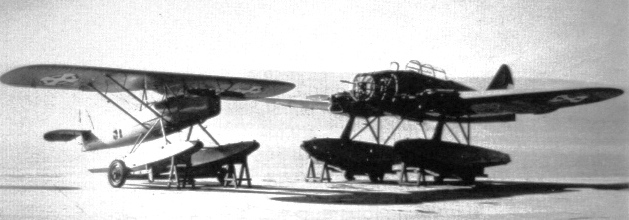Rogožarski SIM-XII-H on:
[Wikipedia]
[Google]
[Amazon]
The Rogožarski SIM-XII-H () was a Yugoslav trainer single-engine floatplane, with two floats designed in 1938. It was designed and built at the Rogožarski factory in 
SIM-X (SIM-XI i SIM-XII-H) www.airwar.ruairserbia.comРогожарски СИМ-XII-Х
{{DEFAULTSORT:Rogozarski Sim-Xii-H SIM-XII-H 1930s Yugoslav military aircraft Floatplanes Trainer aircraft Parasol-wing aircraft Single-engined tractor aircraft
Belgrade
Belgrade is the Capital city, capital and List of cities in Serbia, largest city of Serbia. It is located at the confluence of the Sava and Danube rivers and at the crossroads of the Pannonian Basin, Pannonian Plain and the Balkan Peninsula. T ...
.
Design and development
The YRAF was unsuccessfully trying to choose the most appropriate seaplane for pilot training so they turned to the Rogožarski factory for help in 1937 and ordered the seaplane school project to be made that would fit in its characteristics to the school plane SIM-X. Since it was not possible to make a simple modification (adaptation of existing aircraft SIM-X) for installation ofEDO
Edo (), also romanized as Jedo, Yedo or Yeddo, is the former name of Tokyo.
Edo, formerly a (castle town) centered on Edo Castle located in Musashi Province, became the '' de facto'' capital of Japan from 1603 as the seat of the Tokugawa shogu ...
floats, chief designed Sima Milutinović
Sima Milutinović ( sr-cyr, Сима Милутиновић, 12 July 1899 – 11 December 1981), was a Yugoslav mechanical engineer and a professor at the Faculty of Mechanical Engineering, at the University of Belgrade, the most prolific Yugosl ...
fitted the plane with a more powerful engine Walter Major 6 190 hp, leading to an increase in aircraft size. Thus, this new high-flying school plane with two floats represented an entirely new plane, designated SIM-XII-H. During 1937, the project went into realization stage, and as early as the end of the year the prototype was ready for testing. The test flight was conducted on February 7, 1938, by test pilot Ivan Koroša in hydro-base Divulje. After the flight tests had achieved satisfactory results, the first batch of aircraft was ordered, which were delivered in mid-1939.
Aircraft SIM-XII-H, a supported two-seat high-flying plane, with engine Walter Major 6 (190 hp), of predominantly wooden construction, with an elliptical cross-section of fuselage entirely made of wood and covered with plywood, wings as the supporting structure made of wood covered with fabric, with rounded ends. On each side, the wings are supported by a pair of inclined struts attached to the fuselage. The fuel tank was located in the central part between the wings, that is, at their junction. The first series of aircraft had two (a pair of) EDO floats installed (EDO Float Model 47).
Operational history
As for experience with the use of aircraft SIM-XII-H, which was called by pilots and technical staff of the aircraft "little SIM", were very positive and the navy command (Royal Maritime Navy) signed a contract with Rogožarski factory on July 15, 1940 for the second series of these plane (4 aircraft) with the difference that these seaplanes were equipped for instrument, or, "blind" flying. Rogožarski delivered these aircraft in five months but without floats as the delivery from Canada was delayed for several months. Upon the agreement reached between the Rogozarski factory and the Navy command, the design and development of domestic aircraft floats was launched, unfortunately this project did not reach completion due to the outbreak ofApril war
The invasion of Yugoslavia, also known as the April War or Operation 25, was a German-led attack on the Kingdom of Yugoslavia by the Axis powers which began on 6 April 1941 during World War II. The order for the invasion was put forward in "Füh ...
. In the pre-war period two SIM-XII-H aircraft were in accidents both in Boka Kotorska
The Bay of Kotor ( sh-Latn-Cyrl, Boka kotorska, Бока которска, separator=" / ", ), also known as the Boka ( sh-Cyrl, Бока), is a winding bay of the Adriatic Sea in southwestern Montenegro and the region of Montenegro concentrated a ...
in 1940. Both aircraft were designated for disposal, so the Navy Command requested approval to install the floats from these planes onto new aircraft ( onto the 2nd series of SIM-XII-H ) considering that these planes were equipped with instruments for instrumental ("blind") flying. When the approval was given, the floats were installed into new planes, so the aircraft in the second series were enabled for use before the war broke out.Петровић, O. (2004). Војни аероплани Краљевине СХС/Југославије (Део II: 1931–1941.). Београд: МВЈ Лет 3
Operators
; *Royal Yugoslav Air Force
The Royal Yugoslav Air Force ( sh-Latn, Jugoslovensko kraljevsko ratno vazduhoplovstvo, JKRV; sh-Cyrl, Југословенско краљевско ратно ваздухопловство, ЈКРВ; (, JKVL); lit. "Yugoslav royal war aviatio ...
9 aircraft
*Yugoslav Royal Navy
The Royal Navy ( sh-Latn, Kraljevska mornarica; sh-Cyrl, Краљевска морнарица; КМ), commonly known as the Royal Yugoslav Navy, was the naval warfare service branch of the Kingdom of Yugoslavia (originally called the Kingdom ...
Specifications
See also
Notes
References
* * * * * * * * *External links
SIM-X (SIM-XI i SIM-XII-H) www.airwar.ru
{{DEFAULTSORT:Rogozarski Sim-Xii-H SIM-XII-H 1930s Yugoslav military aircraft Floatplanes Trainer aircraft Parasol-wing aircraft Single-engined tractor aircraft